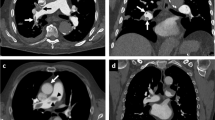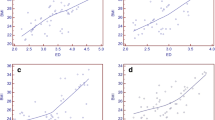Abstract.
The objective of this study was to compare the radiation exposure delivered by helical CT and pulmonary angiography (PA) for the detection of pulmonary embolism (PE), with an anthropomorphic phantom. A preliminary survey defined a representative standard procedure for helical CT and PA (n=148) by choosing the exposure settings most frequently used. Then, radiation doses were measured with thermoluminescent dosimeters TLD 100 (Lif) introduced into the depth of an anthropomorphic phantom. Average doses were approximately five times smaller with helical CT than with PA (6.4±1.5 and 28±7.6 mGy, respectively). The most important doses were abreast the pulmonary apex for CT, and abreast the pulmonary arteries for PA. Compared with PA, helical CT dose distribution was relatively uniform (10–13 mGy). Finally, concerning abdomen and pelvis, doses were more important for PA than for CT scan (0.06–2.86 and 0.2–11.5 mGy, respectively). For the diagnostics of PE, radiation exposure is five times smaller with helical CT than with pulmonary angiography.








Similar content being viewed by others
References
Mills SR, Jackson DC, Older RA, Heaston DK, Moore AV (1980) The incidence, etiologies, and avoidance of complications of pulmonary angiography in a large series. Radiology 136:295–299
Stein PD, Athanasoulis C, Amavi A et al. (1992) Complications and validity of pulmonary angiography in acute pulmonary embolism. Circulation 85:462–468
Alderson PO, Martin EC (1987) Pulmonary embolism: diagnosis with multiple imaging modalities. Radiology 164:297–312
Kelly MA, Carson JL, Palevsky HI, Schwartz JS (1991) Diagnosis pulmonary embolism: new facts and strategies. Ann Intern Med 114:300
Gefter WB, Hatabu H, Holland GA, Gupta KB, Henschke CI, Palevsky HI (1995) Pulmonary thromboembolism: recent developments in diagnosis with CT and MR imaging. Radiology 197:261–574
Schibany N, Fleischmann D, Thallinger C, Schibany A, Hahne J, Ba-Ssalamah A, Herold CJ (2001) Equipment availability and diagnostic strategies for suspected pulmonary embolism in Austria. Eur Radiol 11:2287–2294
Remy-Jardin M, Remy J, Deschildre F et al. (1996) Diagnosis of pulmonary embolism with spiral CT: comparison with pulmonary angiography and scintigraphy. Radiology 200:699–706
Mayo JR, Remy-Jardin M, Müller NL et al. (1997) Pulmonary embolism: prospective comparison of spiral CT with ventilation–perfusion scintigraphy. Radiology 205:447–452
Qanadli SD, El Hajjam M, Mesurolle B et al. (2000) Pulmonary embolism detection: prospective evaluation of dual-section helical CT versus selective pulmonary arteriography in 157 patients. Radiology 217:447–455
Remy-Jardin M, Remy J, Wattinne L, Giraud F (1992) Central pulmonary thromboembolism: diagnosis with spiral volumetric CT with the single-breath-hold technique: comparison with pulmonary angiography. Radiology 185:381–387
Van Rossum AB, Pattynama PM, Ton ER et al. (1996) Pulmonary embolism: validation of spiral CT angiography in 149 patients. Radiology 201:467–470
Becker C, Schatzl M, Feist H et al. (1999) Assessment of the effective dose for routine protocols in conventional CT, electron beam CT and coronary angiography. Rofo Fortschr Geb Rontgenstr Neuen Bildgeb Verfahr 170:99–104
Barkhausen J, Stoblen F, Muller RD, Streubuhr U, Ewen K (1998) Effect of collimation and pitch on radiation exposure and image quality in spiral CT of the thorax. Aktuelle Radiol 8:220–224
Chang LL, Chen FD, Chang PS, Liu CC, Lien HL (1995) Assessment of dose and risk to the body following conventional and spiral computed tomography. Chung Hua I Hsueh Tsa Chih (Taipei) 55:283–289
Mini RL, Vock P, Mury R, Schneeberger PP (1995) Radiation exposure of patients who undergo CT of the trunk. Radiology 1995:557–562
Remy-Jardin M, Baghaie F, Bonnel F, Masson P, Duhamel A, Remy J (2000)Thoracic helical CT: influence of subsecond scan time and thin collimation on evaluation of peripheral pulmonary arteries. Eur Radiol 10:1297–1303
McCollough CH, Zink FE (1999) Performance evaluation of a multi-slice CT system. Med Phys 26:2223–2230
Moro L, Bolsi A, Baldi M, Bertoli G, Fantinato D (2001) Single-slice and multi-slice computerized tomography: dosimetric comparison with diagnostic reference dose levels. Radiol Med 102:262–265
Huda W, Atherton JV, Ware DE, Cumming WA (1997) An approach for the estimation of effective radiation dose at CT in pediatric patients. Radiology 203:417–422
Author information
Authors and Affiliations
Corresponding author
Rights and permissions
About this article
Cite this article
Resten, A., Mausoleo, F., Valero, M. et al. Comparison of doses for pulmonary embolism detection with helical CT and pulmonary angiography. Eur Radiol 13, 1515–1521 (2003). https://doi.org/10.1007/s00330-002-1522-z
Received:
Revised:
Accepted:
Published:
Issue Date:
DOI: https://doi.org/10.1007/s00330-002-1522-z




